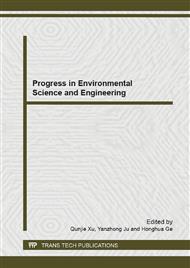[1]
Jinyi Sun: Nitrogenous Wastewater Treatment Technology and Application (Chemical Industry Press, China 2003)(in Chinese).
Google Scholar
[2]
Tingkang Yu, Jian Yang: Techniques and Equipment for Environmental Pollution Control, Vol.1-5(2000), pp.54-60(in Chinese).
Google Scholar
[3]
Baojiu Xu, Tengrui Long: Contemporary Principles of Water and Wastewater Treatment (Higher Education Press, China 2000) (in Chinese).
Google Scholar
[4]
Fu Chen: A Complete Collection of Water Treatment Techniques and Medicament (China Petrochemical Press, China 2000) (in Chinese).
Google Scholar
[5]
Taoguang Bai: Southwest Water & Wastewater, Vol.24-6(2002), pp.23-27 (in Chinese).
Google Scholar
[6]
Dong Liu, Xiantao Zhou, Shikui Yang: Journal of Southwest Nationalities College (Natural Science Edition), Vol.28-3(2000), pp.302-306 (in Chinese).
Google Scholar
[7]
Wenjun Wang, Wenhua Wang, Yabing Huang: Advances in Environmental Science, Vol.7-5(1999), pp.43-51 (in Chinese).
Google Scholar
[8]
Congliang Wang, Xinglong Hu, Shichao Qian: Environmental Science and Technology, 2(2001), pp.28-31 (in Chinese).
Google Scholar
[9]
Jian Yang, Yifan Wu, Shuqian Wang, et al.: Environment Herald, 4(2000), pp.16-18 (in Chinese).
Google Scholar
[10]
Guanwen Cheng: Journal of Guilin Institute of Technology, Vol.16-1(1996), pp.58-65 (in Chinese).
Google Scholar
[11]
Hongyu Wang, Kai Yang, Wenhui Jia, et al.: Environmental Technology, 2(2002), pp.38-42 (in Chinese).
Google Scholar
[12]
Axiang Yang, Tianling Zheng, Yousheng Zheng: Yunnan Environmental Science, S1(2000), pp.153-157 (in Chinese).
Google Scholar
[13]
Yunxiao Chong, Hongying Hu, Yi Qian: Techniques and Equipment for Environmental Pollution Control, Vol.4-2(2003), pp.36-40 (in Chinese).
Google Scholar
[14]
Bin Zhu, Feixing Chen, Zengqi Chen: Shanghai Environmental Sciences, Vol.21-9(2002), P. 564-567 (in Chinese).
Google Scholar
[15]
Jie Wu, Zuoming Yu: China Environmental Science, Vol.21-6(2001), pp.540-544 (in Chinese).
Google Scholar
[16]
Weimin Quan, Xinqiang Shen, Lijiao Yan: Chinese Journal of Applied Ecology, Vol.14-11(2003), pp.2057-2061 (in Chinese).
Google Scholar
[17]
Xiaoying, Guoxiang Wang, Peimin Pu: Journal of Lake Sciences, Vol.14-2(2002), pp.139-144 (in Chinese).
Google Scholar
[18]
Yushu Wu, Guoying Yu: ACTA Scientiae Circumstantiae, Vol.11-4(1991), pp.411-416 (in Chinese).
Google Scholar
[19]
Mang Dai, Leyi Ni, Ping Xie, et al: ACTA Hydrobiologica Sinica, Vol.23-2(1999), pp.97-101 (in Chinese).
Google Scholar
[20]
Feixing Chen, Bin Zhu: Shanghai Environmental Sciences, Vol.21-8(2002), pp.469-472 (in Chinese).
Google Scholar
[21]
Ministry of Environmental Protection of the People's Republic of China: Methods for Water and Wastewater Monitoring and analyzing (Edition 4)( China Environmental Science Press, China 2002) (in Chinese).
Google Scholar


